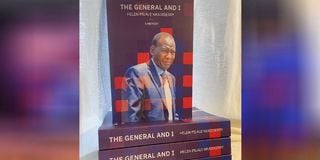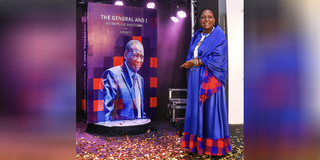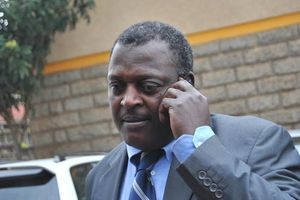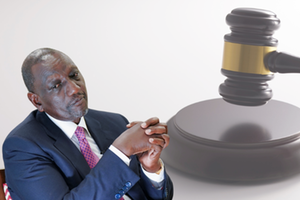Breaking: Autopsy reveals how Cyrus Jirongo died
Premium
The untold story of General Joseph Nkaissery

The cover of The General and I, a book authored by his wife Helen Pilale Nkaissery.
Tall, fierce and regal, Major-General (Rtd) Joseph Kasaine Nkaissery was just the man President Uhuru Kenyatta needed to rein in runaway insecurity when he appointed him to the critical docket of Interior and Coordination of National Government in December 2014.
Killings in Mandera, Mombasa and Nairobi by the Somali-based militia, Al-Shabaab, as well as bandit attacks in such places as Kapedo on the border of Turkana and Baringo counties had given President Kenyatta a constant headache.
So badly did the President need a firm hand in the security docket, that he was willing to look across the political divide for a solution. The President needed someone to replace Mr Joseph Ole Lenku, the languid hotelier from Loitokitok who appeared not to have a handle on the docket. And Nkaissery, a retired soldier of rank, though then an Opposition MP, came highly recommended.
The no-nonsense disciplinarian had served in the Kenya Defence Forces for 30 years, leaving at uppermost echelons of the military command to run for MP Kajiado Central which he would win for three consecutive terms from 2002 to 2013.
Nkaissery had also been an Assistant Minister for defence in the Grand Coalition Government of President Mwai Kibaki and Prime Minister Raila Odinga.
And the General, as he was called regardless of his higher rank, took his job with gusto, rubbing many including his fellow Maasai politicians the wrong way while at it.

Ms Helen Pilale Nkaissery during the unveiling of her book The General and I.
But true to his billing, he was largely successful in combating crime save for the baptism of fire which welcomed him to the ministry when a terrorist attack at Garissa University led to the death of 148 students.
While all this is in the public domain, for the first time the inside story of a top politician and fast-paced career military man as seen through the lenses of his family can be told.
Political ring
The General and I, authored by his wife Helen Pilale Nkaissery, offers a rare glimpse into the pleasures – and the pain of a public family. She poses the question: Do men know what they are plunging their families into when they throw their hats into the political ring? For the moment an individual declares interest in a political seat in Kenya, their lives and those of their families are literally turned inside out with their homes becoming public property.
In the book published five years after the death of the minister, Helen details Nkaissery’s last days, including his hectic life as a minister in charge of a vast and sensitive docket and tell-tale signs of clairvoyance.
Nkaissery died in the early hours of Saturday, July 8 2017 on arrival at Karen Hospital after falling at their home in the neighbourhood.
And as if to help dispel the intense rumours of foul play, especially his death coming just five years after Prof George Saitoti – another high-rank Maasai in government died in a plane crash – Ms Nkaissery categorically states: he died of a heart attack.
Known in medical jargon as acute myocardial infarction, doctors explained that the heart’s muscles had died due to lack of blood as a result of a compromised or blocked blood vessel.
The medical explanation that the condition was aggravated by the military man’s big heart (literally) came as a comfort to Ms Nkaissery who chose to read it as proof that her husband was indeed a kind and generous man.
Though widely described as principled and incorruptible, the quintessential Maasai archetype that early white anthropologists described as tall, elegant, handsome, honest, resolute and militant, another portrait emerges: a feminist. For here was a thoroughbred Maasai and a strict military man of high rank who was nevertheless soft, loving and democratic to a hilt on the family front.
A feminist par excellence, Nkaissery literally left his life to his wife and throughout his political and public life the refrain ‘Ask Mama Soila’ was common in Kajiado Central in a half-mocking, half-reverential reference to the politician’s answer to certain requests.
“General was against the hand-out culture in which constituents feel they deserve to be given whatever they ask from their MP. He would support them to pay school fees, hospital bills and many other unending requests that Kenyans bring to their MPs. But when it came to the family business, he believed that should be respected. He didn’t care that “Uliza Mama Soila” would be used to label him voiceless in his home, one who has been sat on as Kenyans describe it,” she writes.
Helen explains that this was a smart design by Nkaissery to protect his family and didn’t care if someone used it to deride him.
But it was not only giving his wife a prominent place in the running of the family affairs that Nkaissery was different from men of his generation (he died aged 67).
In 1971 leading Maasai novelist HR Ole Kulet concluded that it was possible to remain a Maasai while embracing the positive aspects of modernity such as education. And Nkaissery was the epitome of this balance as portrayed in Is It Possible? He was a successful rancher and businessman. But he was more. In the words of former President Uhuru Kenyatta, who wrote the foreword to the book, Nkaissery was a “superlative public servant.”
Kenyatta should know. Besides having worked with the military man in the Cabinet, he had, as Opposition leader in the early 2000s, relied on him as a Shadow Security minister. They had met even earlier “while in high school through my cousin Captain Kung’u.”
But The General and I is also the story of Helen, a teacher, rancher, dairy developer, successful businesswoman, political mobiliser and leader who currently chairs the Ushanga Kenya Steering Committee. Ushanga is charged with empowering pastoral women and girls by developing and marketing their beadwork business.
Helen’s circuitous schooling begins at Loitokitok which in those heady days could only be accessed through Arusha in Tanzania before skirting one’s way back to Kenya through the Tarakea border on the slopes of the Kilimanjaro. Her schooling would later take her to AIC Kajiado, Kapsabet, Tumutumu and finally Kenya Science Teachers’ College in Nairobi where she trained as a Maths and Physics teacher, an education odyssey that inculcated in her values of inclusivity and resilience.
Nakuru High School
After teaching at Nakuru High School she would later resign to concentrate on the family’s ranching and meat-selling business.
Helen and Nkaissery’s union was an act of peacemaking, the two having come from two then warring sections of the Maasai: Matapato (Nkaissery) and Loodokilani (Helen), predating a role the tall and lanky politician will play as a pacifist who never took a hardline stance on national issues of the day.
A highly readable, fast-paced story, The General and I has hilarious anecdotes such as when Nkaissery and Captain Kung’u (Jomo Kenyatta’s nephew) told the President that they were leaving the army to start a livestock-selling business whereupon the ‘Burning Spear’ ordered them back to the barracks with the rider that he wouldn’t hesitate to throw them into Kamiti Maximum Prison if they lingered.
And to show his seriousness, and in line with military rules, he had them locked up for a month in the barracks. They also had to repeat a course at Kenya Armed Forces Training College in Lanet. The two had narrowly escaped revenge attacks in India where they had gone for training. Then Ugandan President, the eccentric Idi Amin, had embarked on his infamous purge on Asians, expelling them from Uganda.
In India, arriving Asians with stories of woe and suffering triggered immense animosity, not just among Ugandans but other Africans as well.
Away from his austere public demeanour, the avowed football lover who supported the (UK) Premier League team, Manchester United, was a humorous man who shared hobbies and easy banter with family, staff and friends.
As Dr Fred Matiang’i, Nkaissery’s successor at the Interior ministry has said: The General and I will be a useful repository to guide the future generations of a functional and rewarding balance between the call of duty, family and personal interest.
On the stylistic front, the author has succeeded in inventing a creative way of telling the stories of subjects who die without publishing their memoirs – and while at it delivering two tales for the price of one.
The book is available from the General Joseph Nkaissery Foundation [email protected] and online via Amazon. [email protected]





